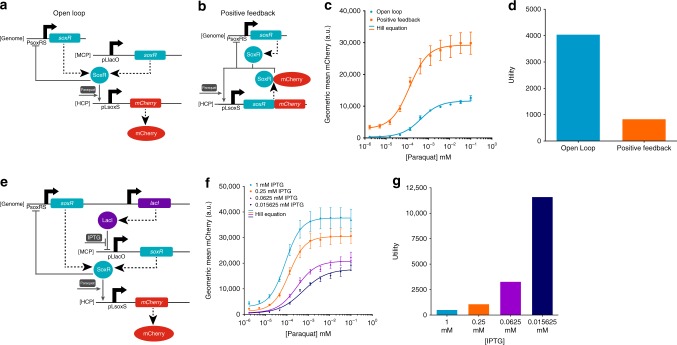Fig. 2.
Paraquat-sensing synthetic gene circuits. a OL paraquat-SoxR-pLsoxS circuit. SoxR is expressed from an unregulated constitutive pLlacO promoter on a MCP, and mCherry is expressed from the pLsoxS promoter on a HCP. b The PF paraquat-SoxR-pLsoxS circuit. A SoxR-mCherry fusion protein positively regulates its own expression from the pLsoxS promoter on a HCP. In both the OL and PF circuits, SoxR is also expressed from the genome and negatively regulates its own expression69. Dashed large arrows represent protein production and solid small gray arrows represent transcriptional regulation. c The empirical paraquat-mCherry transfer function for the paraquat-SoxR-pLsoxS OL (blue) and PF (orange) circuits. The lines are Hill equation fits to the raw data. d The utility for the OL and PF circuits calculated from the Hill functions in Fig. 2c. The OL circuit has a higher utility. e The paraquat-SoxR-pLsoxS OL circuit in E. coli MG1655Pro cells. MG1655Pro constitutively expresses the lacI repressor, which represses the pLlacO promoter and thus soxR expression from the MCP. IPTG induces expression from the pLlacO promoter in this context. f The empirical paraquat-mCherry transfer functions for the paraquat-SoxR-pLsoxS OL circuits at different IPTG concentrations in MG1655Pro. g The utility calculated from the Hill functions in Fig. 2f. The lowest concentration of IPTG yields the highest utility. The errors (s.e.m.) are derived from three biological replicates and flow cytometry experiments, each involving 30,000 events. Source data are provided as a Source Data file

